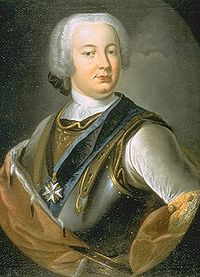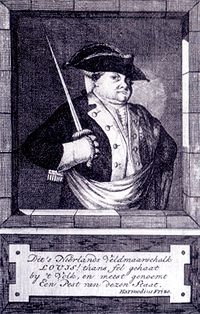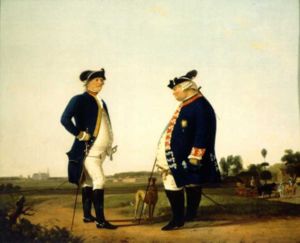- Duke Louis Ernest of Brunswick-Lüneburg
-
Louis Ernest of Brunswick-Lüneburg-Bevern 
Ludwig Ernst van Brunswick-Lüneburg-BevernBorn 1718
WolfenbüttelDied 1788 (aged 69)
EisenachAllegiance Holy Roman Empire, Dutch Republic Service/branch Army Years of service 1737-1784 Rank Field marshal / captain-general Commands held Alt-Wolfenbüttel Infantry Regiment, Dutch States Army Battles/wars Ottoman Wars, Second Silesian War, War of the Austrian Succession, Battle of Soor, Battle of Roucoux, Battle of Lauffeldt Relations Ferdinand Albert II of Brunswick-Lüneburg (father)
Anton Ulrich of Brunswick-Lüneburg (brother)
Ivan VI of Russia (nephew)
Charles William Ferdinand of Brunswick (nephew)Louis Ernest of Brunswick-Lüneburg-Bevern (25 September 1718, Wolfenbüttel – 12 May 1788, Eisenach) was a field-marshal in the armies of the Holy Roman Empire and the Dutch Republic. From 13 November 1750 to 1766 he was the Captain-General of the Netherlands, where he was known as the Duke of Brunswick or (to distinguish him from his eldest brother Charles, who succeeded to their father's title of Duke of Brunswick-Lüneburg) Duke of Brunswick-Wolfenbüttel. Another brother was Duke Ferdinand of Brunswick who led the Allied Anglo-German army during the Seven Years' War.
He was probably one of the first victims of the media in Dutch history.[1]
Contents
Family
He was the third son of Ferdinand Albert II, Duke of Brunswick-Lüneburg, and Antoinette Amalie of Brunswick. He had family ties with various European royal houses. The family was linked by blood to the royal houses in London and Berlin. His brother Anthony Ulrich had married Anna Leopoldovna, a Russian princess and cousin of Empress Anna. (Their son Ivan - Louis's nephew - was appointed Emperor of Russia on his birth). His youngest sister Juliana Maria married King Frederick V of Denmark in 1752. Maria Theresa of Austria and Wilhelmina of Prussia were his cousin (their mothers were sisters) and niece (her mother was Ludwig's sister Louise Amalie). In addition, Wilhelmina's daughter Frederika Luise Wilhelmine, Princess of Orange-Nassau, married Charles George August, a grandson of Louis's brother Charles. Rarely were royal houses so interrelated other as in his case, and this factor was probably the main reason for his supporting the Dutch policy of neutrality during the Seven Years' War.[2]
In the year 1737, he entered the imperial military as Oberst and commander of the Alt-Wolfenbüttel infantry regiments. He took part in the Ottoman Wars from September 1739 until the Treaty of Belgrade. He entered the Netherlands in May 1740 as an Austrian major-general.
Duke of Kurland
After the arrest of the duke of Kurland, Ludwig was elected his successor on 27 June 1741 with the support of his cousin Maria Theresa of Austria. He then went to St Petersburg, and seems to have been interested in marriage with Elizabeth of Russia in the hope to become emperor. However, upon Elizabeth's palace coup on 6 December 1741, his nephew Ivan and all Ivan's German advisers lost their positions, resulting in their exile, imprisonment or departure. Louis Ernest lost his Dukedom of Kurland due to the coup and returned to Germany in 1742.
War of the Austrian Succession
He took part in the Second Silesian War from 1744 as an Austrian field-marshal and therefore fought against his brothers and many of his other relatives, who mostly took the side of Prussia. In the battle of Soor on 30 September 1745, he was seriously wounded, but seems to have appeared on the military scene in the Netherlands as early as the spring of 1746. On 11 October 1746, during the War of the Austrian Succession, he took part in the battle of Roucoux against France. In the following year, he fought in the battle of Lauffeldt as Feldzeugmeister or supreme artillery commander, and met stadholder William IV, Prince of Orange, then involved in border battles against France.
Regent of the Netherlands
In 1749 he entered the Dutch States Army as field marshal by request of William IV, for twenty thousand guilders per annum, although he also retained his position as an Austrian field-marshal and Protestant Generalfeldzeugmeister of the Holy Roman Empire. William's wife Anne was initially sceptical about his appointment and opposed it.
In 1751 he became the governor of the garrison city of Bois-le-Duc, where the stadholder had had particular influence since 1629. After the death of William IV on 22 October 1751 and Anne's appointment as regent, Louis Ernest was appointed captain-general (commander-in-chief) of the Netherlands, reorganising the higher strata of the army. Britain and Prussia asked him to command the allied armies in the Seven Years' War, but Louis Ernest refused out of respect for the Dutch Republic's neutrality.[3] His brother Duke Ferdinand was given command of the Anglo-German army in Hanover in 1757. In 1759 Louis was used as an intermediary in an attempt to mediate the conflict, but plans for a peace congress came to nothing.
From the death of William V's mother Anne in 1759 to William's majority in 1766, he was William's guardian and led the Netherlands' state affairs in his name. The prince called Louis Ernest his second father, but the Frisian nobility under Onno Zwier van Haren opposed Louis Ernest. Simultaneously, Louis Ernest began reforming the stadholder system that had previously appointed qualified persons to the regions in reward for their loyalty. Such favorites had been supposed to take care of local disputes independently.[4] As a result, there was no efficient administrative device in the Republic, nor an equitable apportioning of offices. The prince, losing himself in the details, made it known that he valued advice, which, however, he usually sent back by return of post without any alterations. For a over dozen years he had been drilled by Brunswick and Fagel[who? clarification needed] to believe that his only job was to sign the documents they placed in front of him (and judging from his signature, he was not very good at that).[5]
William's coming of age
After 1766, the Duke was kept on at the irresolute William's request as his privy councillor and as a Dutch field-marshal, with the object, it is thought by some, to keep William's older sister Carolina in check. The "Act of Advisorship" had been set up in secret by the Lord Advocate, Pieter van Bleiswijk, and under this Act Ludwig was to furnish advice by request only.[6] Earlier plans to put in place an advisory council were thus frustrated and in addition, several jealous Dutch noblemen were passed over in favour of the Duke.
It is said that Louis Ernest was instrumental in bringing Prince William V into contact with his niece, Princess Wilhelmina of Prussia. The duke had immediately observed that the princess craved joint rule in state affairs and so was starting to undermine Louis Ernest's dominant position. In long letters she complained about Louis Ernest to her uncle, King Frederick II of Prussia.
Problems and exile
Louis Ernest's accumulated positions and tangled interests led to problems.[7] As early as 1771 there was talk of an attempt on his life in the Hague, but the bullet fired at him passed between his bones. (Rumour had it that an earlier bullet had hit him in his private parts.) Pieter Paulus in 1773 gained national recognition through his book on the stadholder system, in which he took opposition against the Duke of Brunswick. In May 1781 the Republic declared war to England. In June resistance against the duke broke out once more, led by D.W. van Lynden and followed by the Patriots. The Amsterdam mayor Joachim Rendorp pleaded for an advisory council for the prince.
The anti-stadholder party, which gave him the nickname of "the Bulky Duke" (consistent with Frederick the Great's inkling to call him "Fat Louis") recognised the decline of the fleet, the rise of the national army, the outbreak of the Fourth Anglo-Dutch War and the loss of the border towns in the southern Netherlands, and apportioned the blame for all these to Louis Ernest first and foremost.[8] The Patriots argued that Louis Ernest had outrageously neglected the education of the stadholder, so that the stadholder was now unable to take decisions on his own. On 24 May 1782, the duke voluntarily left the Hague and retreated to Government House (the "Gouvernementshuis") in Bois-le-Duc. (It is now the Noord-Brabant Museum).
In the disputes with Holy Roman Emperor Joseph II, who probably tried to help his relative reopened an earlier argument over the buffer-cities, the Scheldt and free trade to the East Indies. Louis Ernest was mistrusted due to his family ties with the emperor and accused of high treason and of selling out on Maastricht. In Issue no. 214 of the patriotic magazine Post van den Neder Rhijn ("the Lower-Rhenish Post"), the Act of Advisorship was made public. On 14 October 1784, Louis Ernest laid down all his offices and left Bois-le-Duc to its new governor, Robert Douglas. The 'Kettle War' was seen by the patriots as the emperor's revenge.
Exile
In 1785, the duke lived in Aachen for a short time. The patriots tried to get hold of his correspondence, using both intrigue and force.[9] Throughout Europe, the nobility came under heavy criticism, and some of the Patriots (anticipating the fate of the nobility and its privileges) followed suit, making public all records relating to the duke so as to broadcast news of his fall right across the continent. The patriots were also energetic that year in organizing provincial armies and exercising free corps and exercitiegenootschappen (military societies) with democratically chosen officers, leading to the first democratically elected city government in the city Utrecht, but also to the occupation of Elburg and Hattem by the Stadtholderian troops in September 1786.
Louis Ernest stayed in Eisenach from 1786, where, with the help of August Ludwig von Schlözer, he wrote his Autobiography and its sequel, his Defence. Both works were soon translated from their original German into Dutch. He was in close contact with the court at Weimar, especially with his niece, Duchess Anna Amalia, and with Duke Charles August. Louis Ernest's nephew, the Duke of Brunswijk-Wolfenbüttel, occupied the Dutch Republic on 13 September 1787, forcing many Patriots to flee the country.
Louis Ernest died in Eisenach in 1788 and was buried in the Welf family vault in Brunswick Cathedral. His diaries, written by his secretary, the 180 pamphlets and publications in the Niedersächsisches Staatsarchiv in Wolfenbüttel, are studied.
Ancestry
16. Henry III, Duke of Brunswick-Lüneburg 8. Augustus the Younger, Duke of Brunswick-Lüneburg (=#24) 17. Princess Ursula of Saxe-Lauenburg-Ratzeburg 4. Ferdinand Albert I, Duke of Brunswick-Lüneburg 18. John Albert II, Duke of Mecklenburg-Gustrow 9. Duchess Elisabeth Sophia of Mecklenburg-Gustrow (=#25) 19. Duchess Elisabeth of Mecklenburg-Gadebusch 2. Ferdinand Albert II, Duke of Brunswick-Lüneburg 20. Maurice, Landgrave of Hesse-Kassel 10. Frederick, Landgrave of Hesse-Eschwege 21. Countess Juliana of Nassau-Dillenburg 5. Landgravine Christina Wilhelmina of Hesse-Eschwege 22. John Casimir, Count Palatine of Kleeburg 11. Countess Palatine Eleonora Catherine of Zweibrücken 23. Princess Katharina of Sweden 1. Duke Louis Ernest of Brunswick-Lüneburg 24. Augustus the Younger, Duke of Brunswick-Lüneburg (=#8) 12. Anthony Ulrich, Duke of Brunswick-Wolfenbüttel 25. Duchess Elisabeth Sophia of Mecklenburg-Gustrow (=#9) 6. Louis Rudolph, Duke of Brunswick-Lüneburg 26. Frederick, Duke of Schleswig-Holstein-Sønderborg-Nordborg 13. Princess Elisabeth Juliana Schleswig-Holstein-Sønderborg-Nordborg 27. Princess Eleonore of Anhalt-Zerbst 3. Duchess Antoinette of Brunswick-Wolfenbüttel 28. Joachim Ernest, Count of Oettingen-Oettingen 14. Albert Ernest I, Prince of Oettingen-Oettingen 29. Countess Anna Dorothea of Hohenlohe-Neuenstein 7. Princess Christine Louise of Oettingen-Oettingen 30. Eberhard III, Duke of Württemberg 15. Duchess Christine Friederike of Württemberg 31. Countess Anna Katherina of Salm-Kyrburg Regnal titles Preceded by
Ernst Johann von BironDuke of Courland
27 June–6 December 1741Succeeded by
Council of the DukeNotes
- This article is based entirely or partially on its equivalent on Dutch Wikipedia.
- ^ Klein, S.R.E. (1995) Patriots Republikanisme. Politieke cultuur in Nederland (1766-1787), p. 12.
- ^ Wijnen, H. van (1987) Vorst Willem, het is alles uw schuld! Oranje en de ondergang van de Republiek bij de omwentelingen 1787-1795, p. 95.
- ^ Bootsma, N.A. (1962) De hertog van Brunswijk, 1750-1759 - Assen: Van Gorcum, Historische Bibliotheek; 69.
- ^ M.A.M. Franken (2000) Dienaar van Oranje. Andries Schimmelpennick van der Oije 1705-1776. Een politieke en bestuurlijke levensbeschrijving van een Gelders luitenant-stadhouder, p. 186-9, 229.
- ^ Schama, S. (2005) Patriots and Liberators: Revolution in the Netherlands, 1780-1813, p. 55-9.
- ^ Rowen, H.H. (1988) The princes of Orange, p. 196-7; Leeb, I.L. (1973) The Ideological Origins of the Batavian Revolution, p. 111-2.
- ^ (1995) The Dutch Republic, Its Rise, Greatness, and Fall 1477-1806, p. 1092-3. Clarendon Press, Oxford.
- ^ Schama, S. (1977) Patriots and Liberators. Revolution in the Netherlands 1780 - 1830, p. 55-6.
- ^ Schlözer, A.L. (1786) Lodewijk Ernst, hertog van Brunswyk en Lunenburg ... Echte bescheiden Van het gedrag ten opzigte zijner aanzienlijke waardigheden, als Veldmaarschalk, Voogd en Reprezentant van ... den Heere Erfstadhouder P.W. de V. van Oranje; in de Vereenigde Nederlanden.
Bibliography
- C. Römer, Braunschweig-Bevern, Ein Fürstenhaus als europäische Dynastie 1667–1884, S. 68, Braunschweig, 1997.
External links
- Entry in ADB
- Text on Ludwig Ernst in Biografisch Woordenboek van Noord en Zuid (Wassenaar, 1941) by Kornelis ter Laan, online at the Digitale Bibliotheek voor de Nederlandse Letteren
- Ernst Ludwig on the website Die Welfen
Categories:- 1718 births
- 1788 deaths
- Austrian Field Marshals
- History of the Netherlands
- People of the Patriottentijd
- House of Brunswick-Bevern
- Recipients of the Order of St. Andrew
Wikimedia Foundation. 2010.


